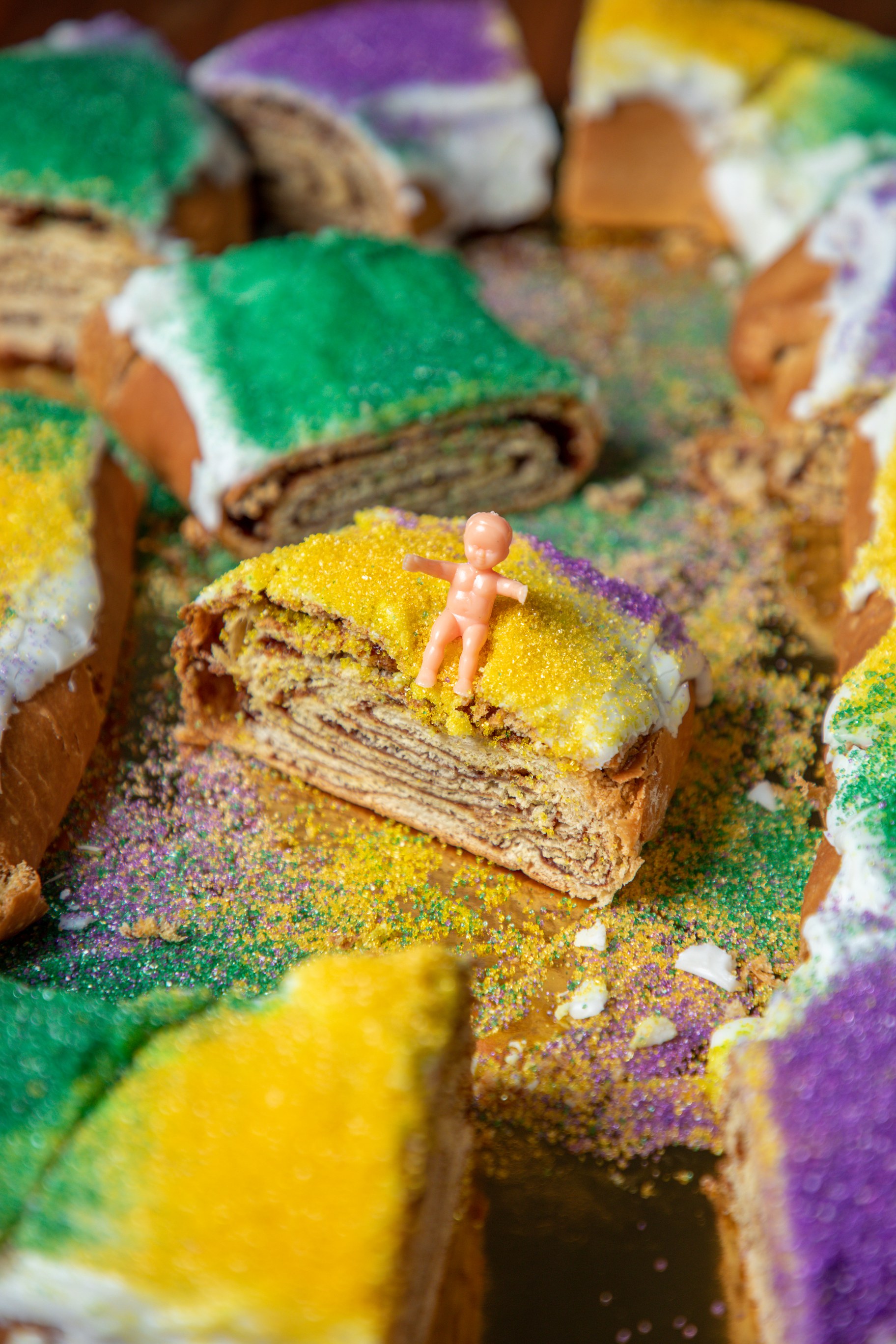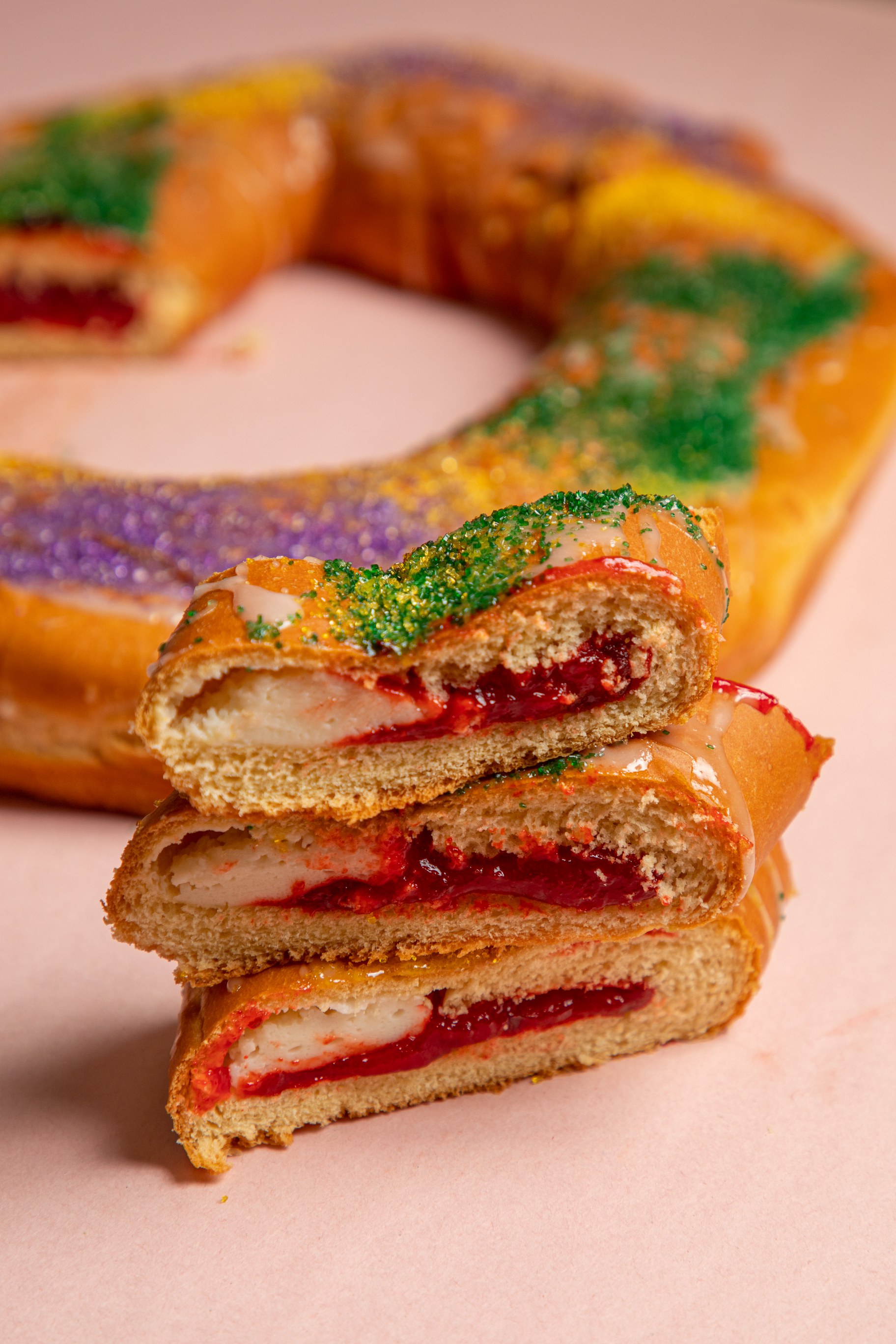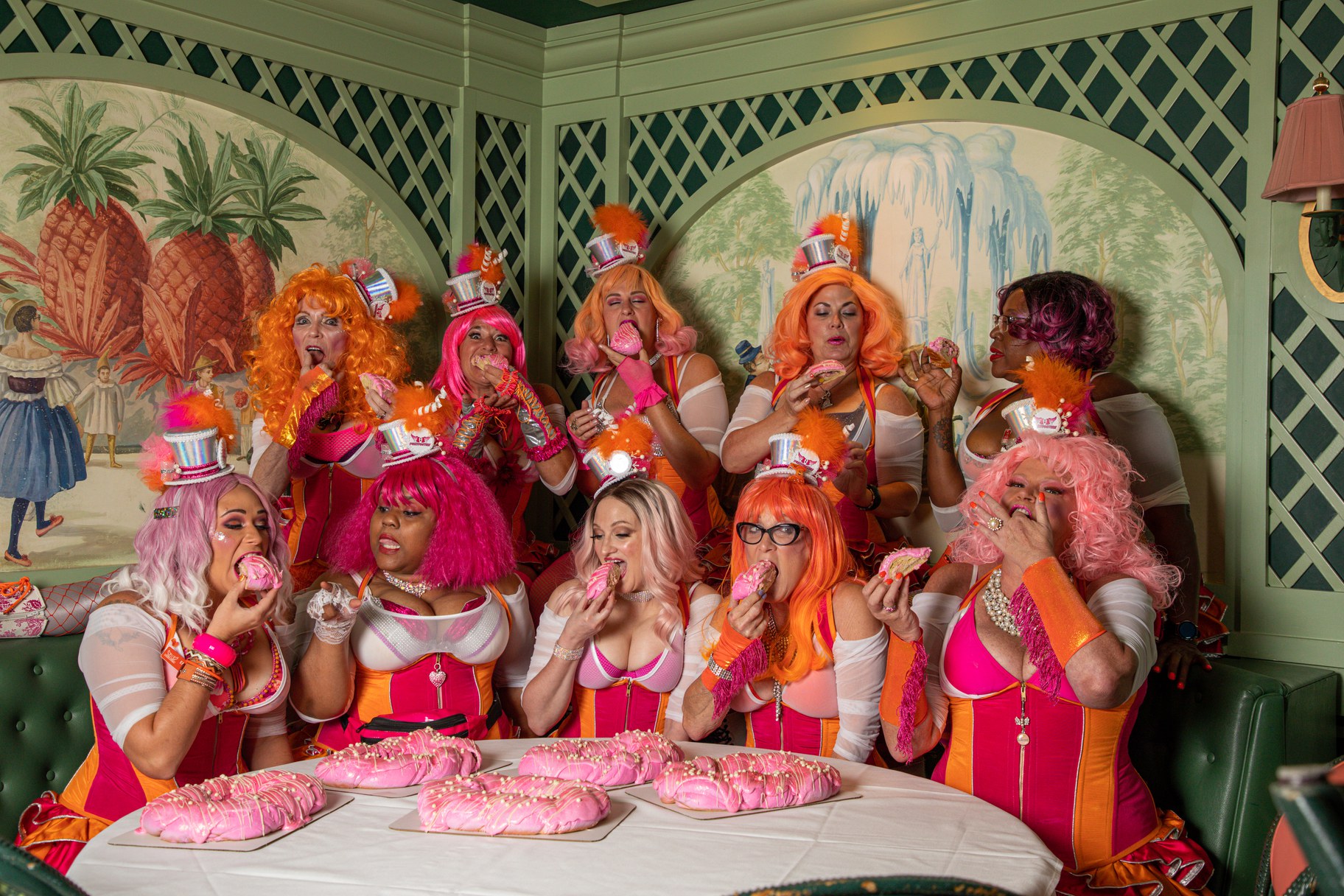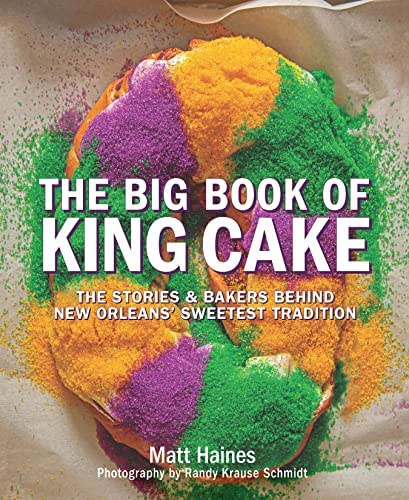What's purple, gold and green all over? Here's a hint: It's sweet, filled with cream, and there's a tiny plastic baby hiding inside. In New Orleans, it’s king cake season – a dessert made with expression of joy and creativity. It's a tradition that crosses communities and cultures, and is a unique expression of the city. Several years ago, writer Matt Haines set out to document these cakes and all their glorious variety. He came away with a coffee table book of photographs and stories from all over the region. “The Big Book of King Cake” is out now.
This interview has been edited for length and clarity.
KCRW: The first time I opened your book, I was just blown away by the variety and the joyfulness that are king cakes and how they express themselves in so many different ways. What made you decide to go on this quest?
Matt Haines: In New Orleans, it's common to have what's called a king cake party. The idea is that all the attendees will bring their favorite king cake, and there's a vote for who brought the best one. It’s a point of pride to introduce others, hopefully, to their new favorite version. I didn't know what my favorite king cake was at the time. This was 2017. So I googled the best king cakes in New Orleans, and I found a top 10 list and I put those in a spreadsheet. And I said, ‘Surely if I try these, the best one, that's what I'll bring.’ But then I found another list that was 15. And so I was like, ‘Those 15 are different from those 10. So I guess I'll have to try 25.’ And by the time I kept adding to this spreadsheet, I was compiling I had more than 100 king cakes to try before the party. And I failed. I only had eight of them that year. But similar to you, I was really blown away by just the incredible variety in the way they looked in the fillings that were being chosen. And what seemed to be important to the different bakers – I had wondered if somebody's ever written a book about this. And it turns out they haven't. And so I got started.

King cakes are enjoyed during the Carnival season in New Orleans, from the Epiphany on January 6 through Mardi Gras. Photo by Randy Krause Schmidt.
What celebration does a king cake mark?
It's typically during what we in Louisiana called Carnival season, which exists between January 6 – the Epiphany or the 12th night of Christmas – and it ramps up all the way through Mardi Gras, or Fat Tuesday. Fat Tuesday and Mardi Gras changes based on the year and where Easter falls. But this year, it's February 21. So it's several weeks of king cake eating, and if you try to king cake outside of season, you'll get it slapped out of your hand by a traditionalist New Orleanian. We're pretty militant about only eating it during this one season.
King cake is eaten in many places around the world, where it takes on several different forms. But why did it find such a welcome home that became an explosion of variety in New Orleans?
In pre-Christian Rome, they were not eating king cake. Instead, they had what was called a Saturnalia cake in honor of their Saturnalia festival. As they spread out across Europe and became the Roman Empire, they brought that tradition, which is different in some ways than what we do today. But they had the idea of hiding something inside the cake.
In New Orleans, we hide a little plastic baby. If you find that baby, you're crowned king or queen of the party, and you have to bring the next cake to the next party. That is a tradition that was even in existence, to some degree in Rome. And still in all of these different places around Europe where the tradition still exists. The French and the Spanish were some of the earliest European immigrants to come to New Orleans. They brought that tradition here.
It really started off as a very humble affair. The cake would only be eaten on January 6, and only in the privacy of Creole homes as they have a kind of a bigger-than-usual dinner on The Epiphany. It wasn't until years later that it was connected to the Carnival season. Because some of those parade crews would have their opening ball of the Carnival season on January 6, and then introduced a lot of people to king cake season, and then they said, ‘Well this is really fun. Whoever gets the baby or whatever else is hidden inside, they have to throw the next party. Instead of waiting a whole year let's just have another party next week.’
Over the decades, instead of just sticking with one kind of king cake, it became a lot more fun to try a bunch of different varieties because you’re eating all these cakes for several weeks. So if you're a chocolate shop in New Orleans now, you're making a chocolate king cake. If you're a Honduran bakery in New Orleans, you've got a guava cream cheese king cake. If you're the insectarium at the zoo in New Orleans, you've got a cricket king cake. There’s really endless varieties.

Nonna’s Sweets Bakery, a Hondruran run operation, combines guava and cream cheese in their king cake, flavors popular to that cuisine. Photo by Randy Krause Schmidt.
“The Big Book of King Cake” is also highly photographed. The photographs are just amazing. There's an enormous amount of variety of shapes and sizes. Three colors stand out as the major element of decoration: Purple, golden green. Where did they come from?
There’s a lot of debate. Some people say the colors come from the story of the Epiphany, which is when the three kings are said to have found the baby Jesus and presented their gifts. Some people believe that three colors are meant to represent those three gifts. The reason that seems most common is that one of the early marching crews and one of the most popular still to this day, is called the crew of Rex. They happened to pick three colors for their emblem: purple, green, and gold. In one of their parades in 1892, They explained what those three colors mean. They said the gold is meant to be wealth, purple is meant to be kingly, and ruling as a king. And the green is meant to be pious and religious. That's probably where that came from.

Members of The Pussyfooters krewe celebrate their twentieth anniversary with Brennan’s strawberry cream cheese king cake. Photo by Randy Krause Schmidt.
What I find so amazing about New Orleans food culture is that one of the reasons it's so vibrant is because it constantly evolves and embraces new people who come who create their own communities and, and the king cake illustrates this as well. Can you share some stories from more recently-arrived communities, bakeries, and people that you met who have bakeries that serve specific communities?
When I was setting out to make “The Big Book of King Cake,” I thought I was creating a book about cake. If that's what it was, it would have been a very beautiful book. But, when I was doing interviews, I quickly realized that this is going to be so much more interesting if it's a book about the people behind those cakes, who are making those cakes and really digging into where the inspirations for their different varieties came from. I think looking at the different groups, particularly new arrivals to New Orleans, and how that impacts cake is really interesting.
Alon Shaya is a James Beard award winning chef here in New Orleans and he moved to New Orleans decades ago. He's from Israel originally, so he grew up eating a whole lot of babka, and he said he really loved babka. When he moved to New Orleans, he fell in love with the traditions here. And so rather than just coming up with a regular old king cake, he decided to create this beautiful and delicious, rich king cake with chocolate babka. It's so nice.
Another one that I really love is I had mentioned earlier a Honduran grocery store. New Orleans has a very big Honduran population. And the owners of the grocery store said that for decades, they were mostly serving other Hondurans. But as their kids started to go to school, they were being introduced to the king cake tradition all around them, there was no avoiding it. (Every Friday at schools in Louisiana, there's going to be a king cake, and whatever child gets the baby and the king cake has to bring the next one. If you've got kids, there’s no avoiding king cake). So that grocery store said that they wanted to come up with a king cake that their community could feel really proud of. They love the taste of guava and cream cheese, it's really common in pastries for Hondurans. They decided to make the first ever guava cream cheese king cake and they said for a couple of years, the only people who were eating it were the Hondurans.
But word started to spread. And one day they opened the door and there was a line wrapped around the storefront. They said that it was the first time they really felt New Orleanian. They felt really proud because this thing that they had created for New Orleanians, that had been here for a long time, that the people held it in high enough regard that it was worth standing in line to get. It felt like they had added something to this tradition that dated back thousands of years earlier.

Matt Haines describes the history and personalization of Carnival season confections in “The Big Book of King Cake: The Stories and Bakers Behind New Orleans’ Sweetest Tradition.” Photo courtesy of Susan Schadt Press.
What about the Vietnamese community? There must be several.
Vietnamese bakeries here are the most famous for king cakes. The most popular in New Orleans right now is Dong Phuong Bakery, and they are a James Beard Award winner. They ship their king cakes, thousands of them, and they sell out within hours of opening up the shipping window. The Tran family owns Dong Phuong. They were living in South Vietnam during the Vietnam War, and Mrs. Tran’s husband was a fighter pilot who was captured and imprisoned. At the end of the war, he managed to escape, and the family fled. They were on a ship headed to Myanmar, where pirates took over the ship and stole everything they had. And they were stuck there. But we're able to get sponsorship over to New Orleans because there was a growing community of Vietnamese refugees. So they were able to make their way over here in the 1970s. But they had nothing left except for each other then. So to make a little bit of money, she learned to be a seamstress. And that made a little bit of money, but not much. So she said she started to bake for this growing Vietnamese community. And that started to make a little bit more money, so much so that she decided to open up a bakery in the 1980s.
But there was no reason to have king cake – that wasn't part of their tradition at all. But when they had grandkids, and they wanted to bring a king cake to school that wasn't just from a gas station or a grocery store, Mrs. Tran thought maybe Dong Phuong could make a king cake that kind of suits the Vietnamese taste. So rather than doing a sweeter sugar icing that's more common, she went for a more savory cream cheese topping and the Dong Phuong king cake is really well known for its unique shape – it's more of a horseshoe. There are interesting ridges along the outside of the cake that are like slices. She said that that came about not by accident, but because as a seamstress, she learned that to help bend fabric – you cut little slices into it. And so to make the dough bend, she did the same thing. She cut the slices. I think that when you look at the 75 different vignettes of the different bakeries in “The Big Book of King Cake,” what I like about it is it feels like it tells the whole story of what New Orleans is like now, including the people have been here for centuries, as well as the people who had been here more recently.
Haines follows up this confectionary quest with his children’s book, “The Little Book of King Cake.”
NOCHI King Cake Recipe
Courtesy of the New Orleans Culinary & Hospitality Institute

The recipe for NOCHI King Cake involves a cinnamon filling, butter, eggs, honey, sugar and food coloring, of course the small plastic baby, and more. Credit: New Orleans Culinary & Hospitality Institute.
Ingredients
Cinnamon Filling:
- 1/3 cup butter
- 1/3 cup brown sugar
- 1 tbsp all-purpose flour
- 1 tbsp cinnamon
- 1 tbsp honey
- 1/2 egg (reserve the other half for the dough)
- ¼ tsp vanilla extract
Dough:
- 2 ½ cups bread flour
- ¾ tsp yeast, instant or rapid rise
- 3 tbsp + 1 tsp sugar
- 1 tsp salt
- 1/3 cup butter
- 1 ½ eggs
- ½ tsp honey
- 2/3 cup milk
Icing and Cake Decorating:
- 2 cups powdered sugar
- ¼ cup whole milk
- 1 tsp vanilla extract
- Sugar and food coloring as desired
- Small plastic baby
Instructions
Start by making the cinnamon filing.
- Melt the butter.
- Pour the melted butter into a bowl and mix with the brown sugar until well combined.
- Add the flour, cinnamon, and honey. Mix well.
- Add the eggs and vanilla extract. Mix well.
- Cover and place in the refrigerator until ready to use.
Next, it’s time to make your king cake dough.
- Place all dough ingredients in a large bowl. Make sure butter is soft.
- Mix ingredients on low speed using a stand mixer for 4 minutes until well combined. If you don't have a mixer, that's also fine; you’ll just need more elbow grease.
- Next, mix ingredients on medium speed for approximately 6 minutes. To check if the dough is ready, tear off a small piece. You should be able to stretch it thin enough to see light coming through without the dough tearing.
- Cover the bowl with plastic wrap or a clean dishtowel and set aside for 30 minutes to begin proofing the dough.
- Transfer the dough to a floured surface and roll into a rectangle with 1 inch thickness.
- Move the dough to a tray or baking sheet and cover it with plastic wrap. Place it in the refrigerator overnight to continue proofing.
- When you are ready to bake, remove the dough from the refrigerator and let it sit for 30 minutes.
- Roll the dough into a rectangle (approximately 20 x 8 inches).
- Spread the cinnamon filling on the rectangle and fold in half lengthwise. Your folded dough should be approximately 20 x 4 inches.
- Cut the dough into 3 even strips lengthwise.
- Stretch the strips to 24 inches each. Braid the 3 pieces, then shape into a circle or oval.
- Line a baking sheet with parchment paper and place the unbaked cake on it.
- Cover and set aside in a warm place for approximately 1.5 hours, or until it’s nearly double its size (for home bakers, a good trick is to place the unbaked cake on the middle rack of an oven that’s off. Place a pan of hot water on the oven floor).
- Bake at 325°F until golden brown or until the cake is at an internal temperature of 190°F. This will be approximately 12 to 15 minutes in a convection oven or approximately 20 minutes in a regular oven.
Finally, everyone’s favorite part – decorating!
- Combine powdered sugar, whole milk, and vanilla extract in a bowl. Mix until smooth and set side.
- To make colored sugars, put sugar into three bowls—one for purple, another for green, and a third for gold. Start with a few drops of coloring, mixing until incorporated. Add more, a few drops at a time, until your sugar is the desired color.
- Once the cake has cooled, lift the cake and insert the baby into the bottom for the future queen or king to find.
- Drizzle the icing over the cake.
- Sprinkle sugar on top, alternating between the three colors.
- Eat and repeat.
